-
Posts
2,406 -
Joined
-
Last visited
Content Type
Profiles
Forums
Gallery
Events
Articles
Posts posted by Ian
-
-
Here are a few recent acquisitions in relation to the `maritime' field of assurance companies
The first is `L'Industrie Francaise', It is undated and there is no record as to the date of its emission and (untypically) there are no edge markings. The only thing known is that the engraver (Massonnet) worked his arts between 1856 and 1905. This jeton is likely to be circa 1860. Interestingly the image Gailhouste portrays in his 1993 catalogue has the figure facinf=g left. the only examples i have seen, the figure faces right.
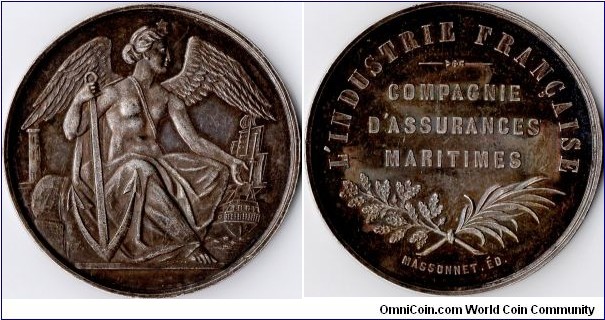
The next is a relatively `blandly' designed jeton issued for the `Union Maritime' an assurer set up in 1847 during the reign of Louis Phillipe. This jeton was the only one issued for this company, which no longer exisists. It was struck in both silver and tin. this example being silver.
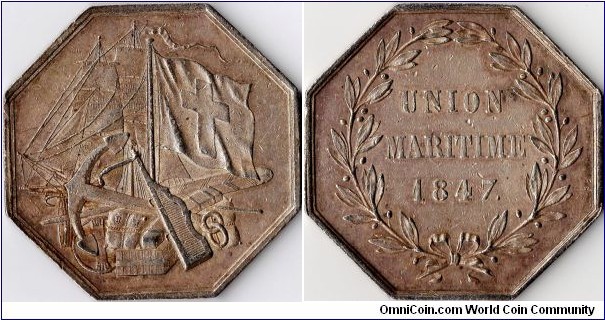
Next is a nice example of a scarcer jeton issued for the `Comite des Assureurs Maritime (Paris)' which was issued between 1845 and 1880. There are two different designs for the obverse, the most notable difference being the design of the ship in the middle distance. On this example the ship is an ancient galley, the other being a galleon type design. This example was struck circa 1845.
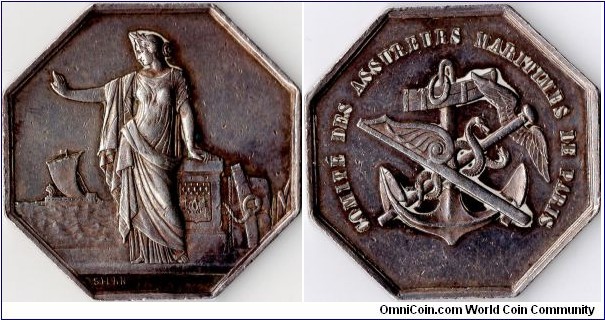
Next is a jeton struck for `Lloyd Rouenaise'. This one, although dated 1866 on reverse and also 1877 (small date in exergue obverse) was actually struck at some point after 1880. The design is the same as the one first issued in 1866 which had a `bee' as an edge marking, depicting its date of issue as 1860-1880. This example has the cornucopia edge marking depicting post 1880.
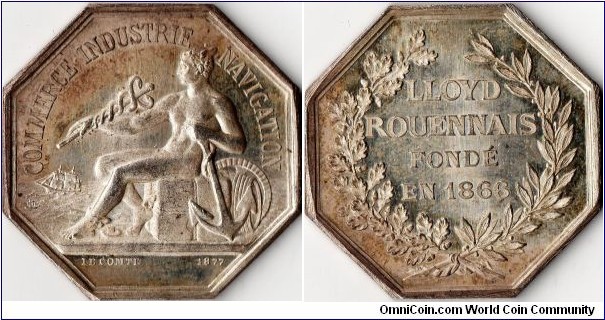
Lastly (for now) is the `Union Des Ports', a french maritime assurer founded in 1832. This jeton was struck in both silver and bronze and was issued between 1832 and 1880. It can be found with three different edge markings 1) a very small incuse Alladin's lamp (1832-41), 2) a hand with the index finger pointing to the right (1845-60) and a bee (1860-80). This example is 1845-60, although i now have examples of all three.
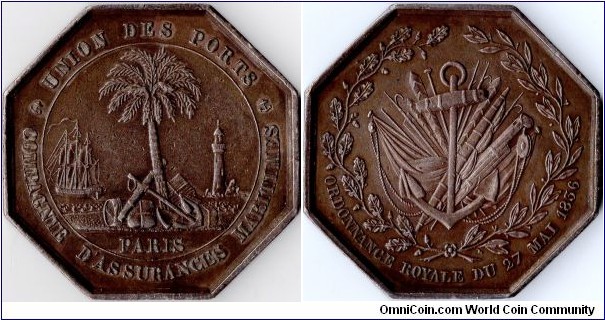
-
Wow, nice find, Ian. Do you have a more exact idea of numbers?
No hard facts available whatsoever, but the number originally struck is likely to be less than 1,000, and we do know that some were struck in bronze (have never seen a bronze example yet). I suspect that the number of surviving examples will be quite low.
-
Jeton de Presence for `La Flotte' a French maritime assurer which came into existence in 1861 and which is no longer in existence
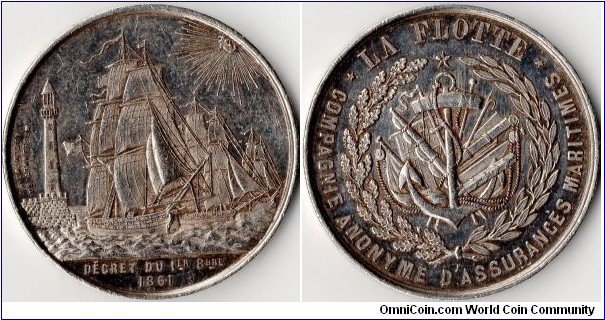
Strange that in more than a decade and a half of scouring auction catalogues and the various ebay sites I had never even come across one. Supposedly as scarce as hen's teeth for a relatively modern jeton, yet within a month of my coming across it in Gailhouste's 1993 book on the subject two appear on ebay. I bought one of them and since then another has appeared. Reminds me of the old addage re the old Heinz tomato ketchup `when at first you shake the bottle, none will come and then a lot'l.' I'mm happy though.
I've had a good run of luck with obtaining some reatively scarce pieces in this field this past month and will probably bore you senseless with their images when i get the chance to scan them all.
-
sounds like you made a steal there. A nice reward for your investment in knowledge........ and a step towards the `Honorary Scot' accolade.

I agree with your take on these pieces. A couple of examples is probably just right for the casual collector.. No doubt, with your superb sleuthing skills, you will manage to acquire a `Leipzig' in due course.
-
Quite a piece of history in that medal, and a nice bit of education provided by you in accompaniment.
I've seen a few of that series on ebay in the past six months or so but have managed to keep my focus on french jetons

-
-
Well spotted sir!!
I was going to comment on the signature and its ramifications, but thought the better of it as the scanned image is quite poor. you must have eyes like a hawk.

The signature is very ad hoc in style. `Arty'......... and in keeping with the theme of the jeton.
-
here's a later example of a jeton issued for the Academie Saint-Luc. Dated 1758 (same reverse die as used during reign of Louis XV) but issued circa 1778 by Louis XVI.
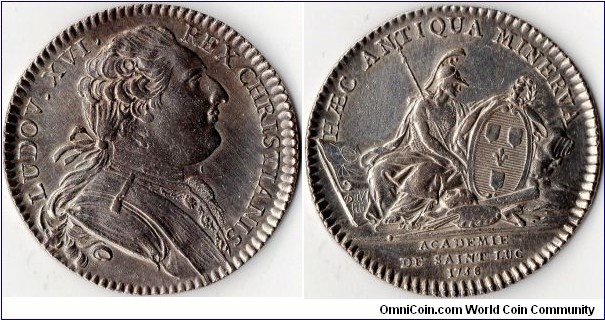
-
yes. In hand you can see that there is still quite a bit of lustre on both sides. It appears to have escaped having been tampered with.
-
I agree. CGB describe the reverse as `La Peinture et La Sculpture se tenant la main' (Painting and Sculpture holding hands)
The symbolism is Painting and Sculpture being equal partners in terms of the `arts' ...while the sun (which appears as a small face radiant in the left field) shines benevolently on them. This references Louis XV (aka `The Sun King') who was still alive and patron of the academy in 1764.
-
A nice example of a scarce silver jeton issued for the Academie de Peinture et de Sculpture. Although dated 1764,there appears to be some doubt as to whether it was issued that year or in the early 1770's. The jeton cites Louis XVI as patron in the obverse legend
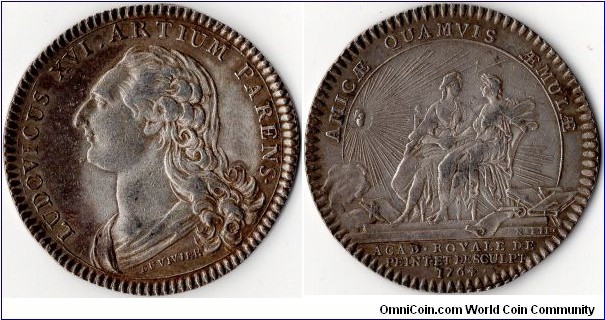
The Academie was founded in 1648 with the purpose of professionalising the artists working for the French court and give them a stamp of approval that artists of the Academie de Saint-Luc did not have. (The Academie Saint-Luc was a painters' guild set up in Paris in 1391 by the Lord Provost of Paris).
-
as always, I have nothing but admiration for your research skills, and your eye for the unusual.
nice one!
-
-
.........if the one on ebay sells for a decent price (ie it finds a market), we might very well start seeing genuine Chinese copies of the USA fake in the not too distant future.
You do seem to come across interesting pieces with great regularity. Good sleuthing and a sharp eye on your part.
All power to you!!
-
another fascinating piece has entered your collection. I am wondering where it was struck. La Medaille, Paris? I'll check out Mitchiner just in case he has made reference to it or if it appears in the mint records he cites.
-
very interesting and intriguing find you have there. I'd try to get hold of a copy of Dalton and Hamer's reference work as first port of call just to make absolutely sure your token is not noted as a variant by them....unlikely as that may appear to be.
Excuse my ignorance on this area but were the original tokens somehow issued for general circulation as coinage in the USA? if so I can understand why `copies' (0r fakes) would be generated. Otherwise i'm struggling to see why this particular token would be selected for attention some considerable number of decades after its first appearance to the world in England.
-
found an example of the 1720 silver jeton issued for Rene Robert. The copper one is earlier in the thread.
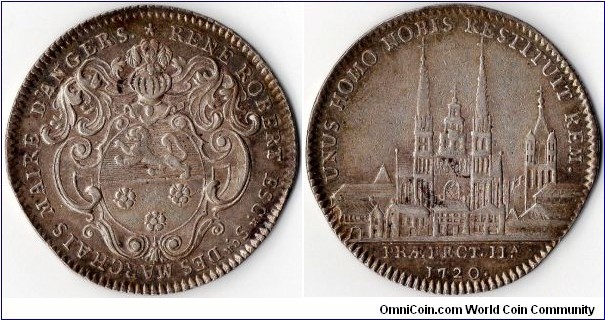
-
This is a silver jeton minted for the `Senegal', a French owned tug boat /salvage company operating out of Dakar, Senegal. It would have been issued to directors for their presence at board meetings. It has the `abeille' (bee) assay mark on the edge (1860-79) confirming it as being an orginal example, and RR. There was a later re-strike (after 1880) distinguishable from the orginal by the cornucopia assay mark on the edge.
This example, although having an edge mounting is otherwise unscathed, and in remarkably good condition
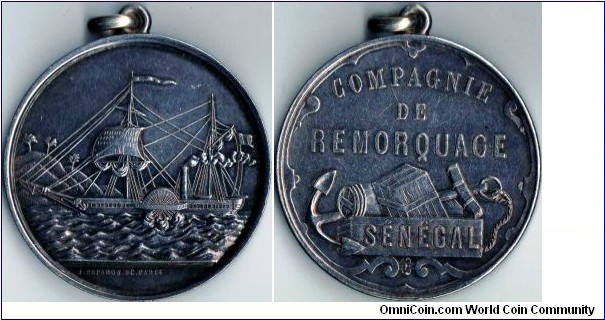
-
indo-china perhaps (?)
9
-
I think it was just issued as a reckoning counter during the Regency of Anne of Austria, not for any other event/reason. Not dated but I believe the early portraits were used between 1643-1646. Ian will know.
R / bust of Louis XIV to right. - B lying between 2 points (Nicolas Briot) - Feuardent 12,439.
http://www.saivenumismatique.com/article.asp?langue=de&article=15679
By error you have put Louis XIII in the title, I know that you are fully aware it is XIV or XIIII

The jeton was issued sometime between 1643 -45 during the regency period when Anne was `Queen Governess' (as regent for the young Louis XIV).
This jeton would have been what is commonly known as a `stock' jeton. That is, a a non generic type struck just in case there was anyone missed out from the issues for the general adminstrations, or indeed if there was any shortfall in the numbers required. Such jetons would be `held in stock' against any such emergency requirement and as such could have been released over a period of time, unlike the typical dated jetons which were minted specific for the year noted.
One thing that seems to have escaped everyone's eye/ mention so far is the legend on the reverse (ANNA DG FRAN ET NA ?EG). The R in REG appears as an I....die filling or an error. I can't tell from the image?

Edit: another observation, the jeton in this thread seems to me to be coin rotation. the one on the site referred appears to be medal rotation and most probably a later strike. As an aside, the asking price of 50 euro belongs in the realms of fantasy. With patience you should be able to pick up an example of that jeton for under 10 euro. It is no particular rarity.
-
This one is a more modern (circa 1914) medal issued by La Populaire. It appears to be the only piece they ever issued. This example appears to be some sort of service recognition for the individual named on the reverse.

-
Not all variants have the crown However may I suggest you look for Rouyer 1160 (my apologies, now that i've put my glasses on
 ) That reference is the appropriate fit.
) That reference is the appropriate fit.Unfortunately CGB seem to have changed their site. You used to be able to research the content of their catalogues (of which Jetons XX is one). I think they are intending selling these as electronic downloads, hence the reason why (possibly) they no longer appear to be accessible via their web site.
(edit) ..................A little bit of sleuthing later see this link:
http://www.cgb.fr/rouyer-viii-jetons-classes-par-types-jeton-de-compte,fjt_090341,a.html
-
I can see the colon punctuating the reverse legend (ie MARIA : GRACIA) on the reverse. if you look closely you'll see that it is actually two small star shapes. No need for a microscope if i can see it .......and i'm as blind as a bat without my glasses

-
I think you are mistaken about the number of fleur de lis there are obverse. I think there are six...there are certainly more than
three
If i'm right, then it looks to me to be the spitting image of Rouyer 1161 (of which there are quite a number of variants)

They appear in CGB's `jetons XX' - jetons et mereaux du moyen age.
the description is given as (obverse): AVE MARIA . GRACIA . PLENA (shield with six f de l within a rosace of six lobes)
(reverse): AVE MARIA : GRACIA P (the `colon' punctuating the legend consists of two small stars) In
the centre a cross `fleurdelisee' (ie a f de l on each point) with a f de l at its centre.
Jetons XX is dated 2004 and gives a value for a Fine example as 7 euro.
The variations are in relation to the legends .i cant fully read yours with certainty, but it is certainly Rouyer 1161 or a variant of it. I




Numismatique de L'Assurance
in Exonumia (Tokens, Medals, etc) Forums
Posted
Yes. probability is extremely high that it is merely a printing error. I've now seen at least three examples like mine but not a single example as it appears in the book. Maybe the printer had too much wine that day.